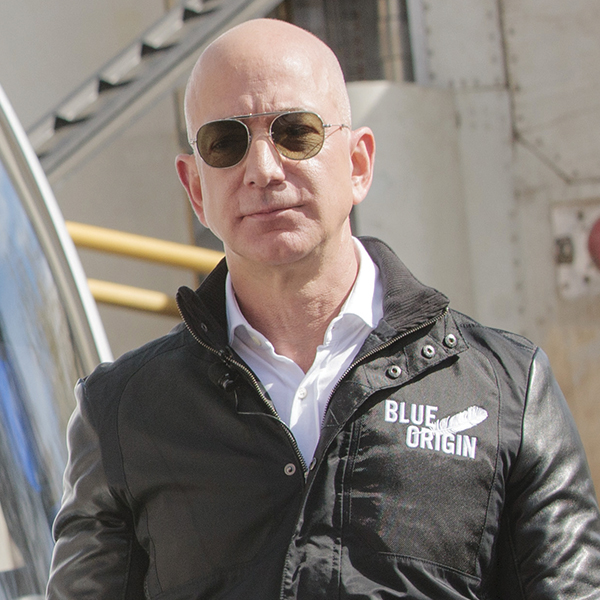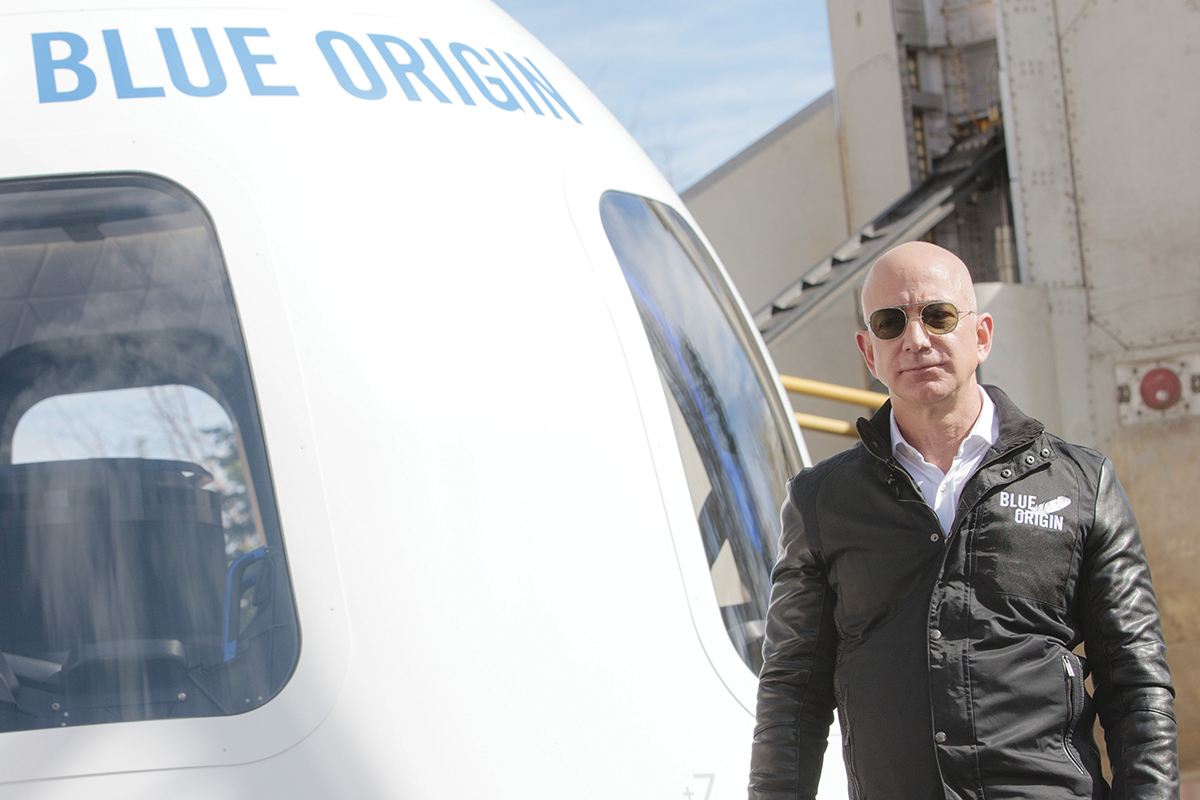From tourism to telecommunications, start-ups and established players are competing in a new space race that sees companies, not nations, jostle to make the most of the vast commercial opportunities on offer beyond Earth.
Virgin Galactic first to launch?
At the forefront of the corporate push into orbit are three tech billionaires locked in fierce competition to make commercial space travel a reality. Leading the charge is Sir Richard Branson, who co-founded Virgin Galactic in 2004 with the aim of establishing the world’s first commercial space carrier.
Fast-forward 13 years and the company, from its futuristic base in California’s Mojave Desert, is rapidly advancing plans to fly customers into suborbital space on board its six-passenger SpaceShipTwo. At an estimated cost of US$250,000 per seat, select cashed-up passengers will get a 90-minute trip that includes four minutes of complete weightlessness in space.
Branson, currently worth an estimated US$5 billion according to Forbes, is confident of launching Virgin Galactic’s first commercial voyage sometime in 2018. If successful, the milestone would be a dream come true for the eccentric entrepreneur.
“It has been my long-held dream to open access to space to change the world for good. We have been striving to do that by manufacturing vehicles of the future, enabling the small satellite revolution, and preparing commercial space flight for many more humans to reach space and see our home planet,” he said recently, announcing the creation of Virgin Orbit, a stand-alone company specialising in low-cost launch services for small satellites.
The competition is out of this world
One of Branson’s biggest competitors, Elon Musk, has already made significant progress, revealing this year that two private citizens have paid the company undisclosed sums for a trip around the moon in coming years. Adding to its market-leading position, SpaceX is also the only private company ever to return a spacecraft from low Earth orbit, and it was the first firm to deliver cargo to the International Space Station.
The third big commercial player in space, Blue Origin, is owned by Amazon’s Jeff Bezos. Like Musk, billionaire Bezos, via his private spaceflight corporation, wants to populate other planets. But first, he plans to send paying customers into sub-orbit, a staggering 93,573 metres above Earth.
Using its six-seat, tourist-friendly New Shepard vehicle, which claims to have the biggest windows in spacecraft history, Bezos’s ambitious project will directly compete with Branson’s Virgin Galactic offering.
Fleet plans to launch its first nano-satellite in 2018, with its ultimate goal to deploy 100 of the miniature devices into space.
Bezos also plans to roll out New Glenn, a massive orbital vehicle that he aims to start flying by 2019. In a sign of the strong demand for space services, New Glenn has already been booked to launch a geostationary satellite for Eutelsat Communications, sometime in 2021 or 2022.
Billionaire space races
Jeff Bezos

Company name: Blue Origin
Wealth: $81.4 billion
Spaceship: New Shepard
How he made his money: Founded Amazon
Lift off: Estimated 2018
Elon Musk

Company name: SpaceX
Wealth: $20.7 billion
Spaceship: Dragon 2
How he made his money: Founded PayPal; Tesla, Inc.
Lift off: Estimated 2018
Sir Richard Branson

Company name: Virgin Galactic
Wealth: $5 billion
Spaceships: WhiteKnightTwo, SpaceShipTwo
How he made his money: Founded Virgin Group
Lift off: Estimated 2018
It’s little wonder that more businesses, and especially bold entrepreneurs, are looking skyward as the space economy booms. Commercial space activities are estimated to be worth around US$246 billion annually, with that number likely to rise dramatically over the coming decade as more opportunities are unlocked. Indeed, commercial space activities are now outpacing government space agency activities, and currently represent three quarters of the global space economy.
Game-changing telecommunications
While billionaire-led companies are the most well-known players in this arena, a host of start-ups are also working on exciting, and potentially breakthrough, projects. Sky and Space Global is one such promising Australian company at the cutting edge of the race.
Sky and Space Global
The ASX-listed disrupter plans to create its own telecommunications network based on a constellation of up to 200 nano-satellites – smaller, cheaper orbital devices than their conventional counterparts. Once operational, Sky and Space Global believes its network of mini satellites will provide connectivity to millions of people in remote parts of the world and to industries, such as shipping and aviation, that are poorly serviced by telcos.
The company’s CEO, Meir Moalem, says he is targeting emerging markets in South America, Central Africa, and South East Asia with what he believes represents a game-changing telecommunications solution. “This technology will allow telecom operators, enterprises and communication service providers to deliver affordable connectivity services to remote locations that don’t have access to reliable and affordable connectivity services,” Moalem explains. “Our ultimate mission is to provide affordable communications services to anyone, anywhere, anytime.”
Moalem, a former Israeli air force pilot, says commercialising space is about meeting the demands of today’s consumers, especially when it comes to mobile-based connectivity. Sky and Space Global’s offering is particularly timely, he says, given the three million people worldwide who are still unable to access mobile coverage due to remoteness.
The company also has the imprimatur of Virgin Galactic, recently inking a deal with the industry behemoth to use the company’s LauncherOne vehicle for its nano-satellite roll-out. “As our world is becoming increasingly interconnected, the demand for affordable connectivity is growing dramatically. This growth is partially driven by the increasing adoption of mobile technology in emerging markets and by the growing demand for data,” Moalem says.
“For the full potential of mobile communications to be realised, the citizens of these countries need cost-effective access to mobile networks, affordable devices and data services. Nano-satellites have the potential to provide affordable connectivity to anyone, anywhere, anytime in the world and offer an excellent alternative to traditional satellite communications, which are very costly.”
The challenge is real
At the same time, Moalem concedes that operating in the emerging commercial frontier of space is not without challenges. Despite already selling some of its nano-satellite communications bandwidth, Sky and Space Global’s success means constantly hitting lofty milestones in order to firm up the viability, he says.
“We have been working hard to test and validate every feature of our satellites in order to secure our success,” Moalem said in June, ahead of the launch of the company’s demonstration nano-satellites, the 3 Diamonds. “Our main challenge is to continue to meet our deadlines and our milestones, and to push forward with the development of our commercial constellation.”
Sky and Space Global is not the only company seeking to make its fortune in the space economy, which describes a range of businesses including telecommunications services, tourism, Earth-observation satellites, rockets, and geo-spatial products.
Gilmour Space Technologies
Another exciting start-up, Gilmour Space Technologies, has a vision to provide businesses with low-cost access to space via its proprietary launch vehicles. CEO Adam Gilmour, who founded the Queensland-based engineering firm in 2012, describes the company’s aims as similar to those of SpaceX, except targeted at delivering smaller payloads with its rockets.“We want to be leading that charge,” Gilmour says.
“Satellite capability has been dramatically increasing in small-sized satellites, in the same way it has with mobile phones and other computing devices on Earth. With access to our lower-cost, small-payload rockets, we believe more and more entrepreneurs will be able to engage and open up new markets in the sector.”
For Gilmour Space Technologies, progress has so far been pleasing. In 2015, the company became the first private firm in Australia to launch a hybrid test rocket using 3D-printed fuel. Earlier this year, it raised $5 million in venture capital to pursue its growth objectives. Starting out with three engineers, the company expects to have around 27 staff by the end of 2017, setting it up to forge ahead with development of its suborbital and orbital rockets.
While the future is bright, Gilmour is aware that hurdles lie ahead, including assembling the right team of engineers for the complex project. “A big challenge for us has been in finding talented engineers with relevant space experience in Australia and Singapore, particularly in rocketry and propulsion,” he says. There is also the tricky issue of finding a launch location.
While Sky and Space Global has chosen the facilities of the Indian Space Research Organisation, Gilmour plans to look closer to home ahead of a planned test launch in 2017–18. “There is a lot of work ahead if we want to get a launch pad ready in Australia. We are considering other sites, but it would be ideal to have one here,” the former Citibank financier says.
“The next 12 months will see us further develop and test our large motor, and conduct at least one suborbital launch to above 70 kilometres in altitude. This would help prove our technology and allow us to raise the next round of funding.”
Fleet Space Technologies
In Adelaide, another Australian space start-up is also impressing investors. Fleet Space Technologies also wants to use nano-satellite technology to bring about a revolution in telecommunications. The key difference, however, is that Fleet wants to connect things, not people.
The company, led by CEO and space engineer Flavia Tata Nardini, aims to build the IoT revolution by creating infrastructure to connect billions of sensors and devices to the internet. Fleet believes its solution will be huge for industries like agriculture, shipping and mining. It plans to launch its first nano-satellite in 2018, with its goal to deploy 100 of the miniature devices into space.
“Our goal is to create a digital memory system around the globe with a fleet of nano-satellites,” Nardini says. “Our idea is to connect devices, and we are very much into industrial applications. Industry is changing, and what they want to do is measure more.”
The company has already inked pilot partners in Australia, Europe and the US, and earlier this year locked down a $5 million capital injection from investors, including Atlassian’s Mike Cannon-Brookes.
Like other emerging space players, Nardini says, Fleet’s strength is its ability to solve big problems for people back on Earth. She says farmers, for instance, are likely to jump at the company’s solution, which will allow them to get data on things like soil moisture and water temperatures irrespective of where their farm is located. “We want to be as connected as we can with our customers and grow with them,” she says.





